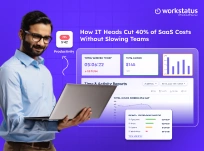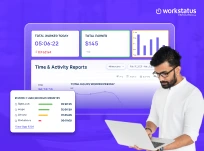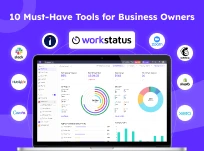Table of Contents
Workforce management continues to undergo transformation. Remote employees and mobile teams require new control and communication mechanisms. Tools that collect and display employee actions on their mobile devices in real time enable managers to make quick yet informed decisions. The role of mobile tracking tools in workforce management goes beyond simple time tracking. Integrating location data with performance data increases operational transparency and the quality of management decisions. So, how does it all work?

From Accounting to Operational Transparency
Real visibility is the first significant contribution of mobile tracking tools. Managers receive not just an “in/out” tag, but context:
- Where was the employee?
- How much time was spent traveling? How much time was spent on a specific task?
- Were there any deviations from the plan?
Such granular information allows you to:
- Avoid over-assigning tasks;
- Improve the accuracy of time estimates;
- Build KPIs in a new way.
Combining GPS tracking with internal task logs allows you to:
- Move from reactive response to forecasting resource needs;
- Quickly adjust routes;
- Increase team throughput.
At the same time, if you need to quickly find a device or get a location by number within the permitted limits, there are also services that work via links in SMS or messengers for such purposes. One such approach allows you to send the recipient a text with a link, and after tapping it, the system shows the position. To see an example of how this idea is implemented, you can visit the website where the “Detect by Link” feature is implemented. At the heart of this scenario is a phone tracker, which positions itself as a service for finding a location by phone number and as a phone tracker tool without installing additional apps. Its mechanism is based on sending tracking links that reveal the current location when the user takes action.
Mobile Workforce Management and Changes in Control and Planning
Combining location data with schedules and tasks allows you to create specific rules. For example, automatically redirecting a technician to the nearest emergency request when the estimated time of arrival exceeds the acceptable value. Or dynamically recalculating routes when traffic changes. This reduces response time and lowers operating costs. At the enterprise level, this logic is implemented through mobile workforce management software, which includes:
- Dispatcher modules;
- Route optimization;
- Travel history for financial reimbursement and verification of completed visits.
Technological details
The architecture of modern solutions includes:
- Collection of telemetry from the device;
- Offline data caching;
- Use of digital signatures to guarantee the integrity of record;
- Use of timestamps to reproduce the chronology of events.
2FA, linking actions to a specific device, and tamper-evidence mechanisms increase system reliability.

Verification. Security. Data leakage prevention
Mobile tracking generates large amounts of sensitive information. To minimize risks, systems must implement:
- Role-based access policies and encryption of data at rest and in motion;
- Anonymization mechanisms for analytics.
Practical steps
- Limiting the storage time of tracks.
- Access audit.
- Integration with data leakage prevention tools that detect suspicious transfers of location files outside the corporate network.
- Special attention should be paid to access rights. Routes and detailed logs should only be visible to authorized roles. Aggregated metrics should be available to business analysts without personal data.
Operational Benefits. Measuring Effectiveness
To assess the real value of a project, focus on measurable indicators. Namely,
- Average time on site;
- Average travel time;
- Percentage of on-time deliveries;
- Number of emergency redirects;
- Fuel savings;
- Reduction in unscheduled visits.
The data will help you model optimization scenarios.
Industry case studies
In logistics, integrating tracking with the dispatch system reduces delivery times and increases the accuracy of the planning funnel.
In home care and healthcare, mobile tools ensure that nurses visit patients. The timing of medical procedures is recorded for compliance purposes.
On construction projects, tracking helps monitor the presence of crews. It also records the performance of hazardous operations with additional safety checks.
Implementation and Change Management
Transparency and agreement are key components of success. Employees need to know when tracking is active and what information is being used. Therefore, conduct preliminary consultations and training sessions. Set up channels for feedback.

Training. Use of analytics
Data should be used to improve competencies. Namely,
- Regular performance review sessions;
- Individual development plans based on objective metrics;
- Motivational programs that encourage effective practices and increase technology adoption among employees.
Practical recommendations
1. Start by mapping the processes where location is required. Define the expected results.
2. Select a small team for testing. Set an evaluation period and success metrics.
3. Obtain written or electronic consent and keep records. Define data retention periods and deletion procedures.
4. Apply encryption, RBAC, 2FA, tamper-evidence mechanisms, etc.
5. Automate the transfer of confirmed visits to payroll.
6. Implement anomaly monitoring and a response plan for leakage incidents.
7. Train managers and employees. Collect feedback. Expand usage based on results.
Closing Thoughts
Mobile tracking tools are becoming an important part of modern mobile workforce management. However, their value is only realized when technical solutions are combined with ethical policies and strict data protection. And also, with clear communication with employees. By balancing capabilities, organizations can increase transparency and efficiency without compromising privacy.
FAQs
Ques: How can MWM increase your productivity?
Ans: MWM systems also improve performance by easily monitoring employees’ location and movements, hence efficient schedule creation. Less time is wasted, and documents can be easily shared. It helps in directing the available resources appropriately and also in the timely accomplishment of any available assignments.
Ques: Is Mobile Workforce Management fit for all industries?
Ans: Yes, MWM is most advantageous to industries composed of numerous employees on the move, including delivery services, field services, and the sales force; nevertheless, it is versatile enough to be implemented in other industries, inclining to work away from central offices.
Ques: In what ways does MWM promote employee responsibility?
Ans: MWM systems improve another organizational function – accountability because reports and real-time information on employee actions give clear information. This is beneficial to managers as they can oversee the workforce, check their productivity, and adherence to the laid down timetable besides being able to correct defaults, thus producing a responsible and dependable workforce.












